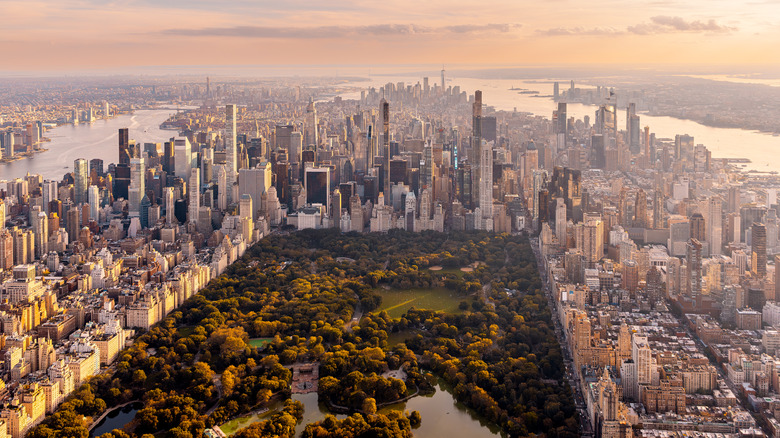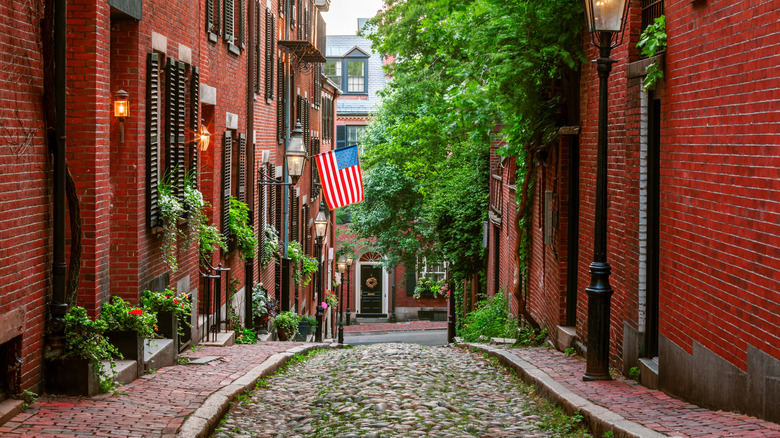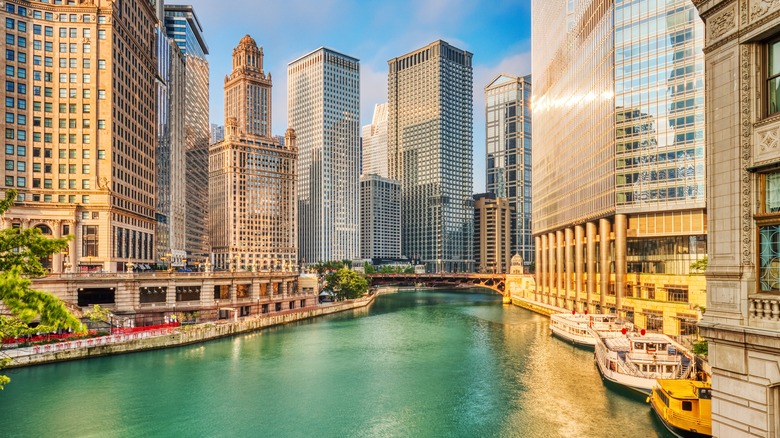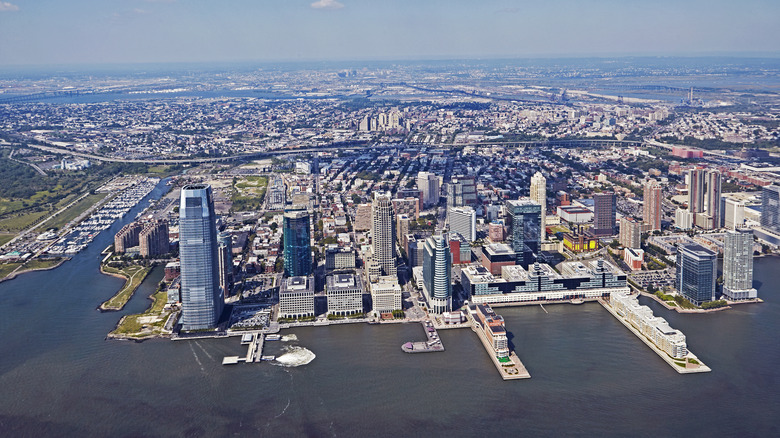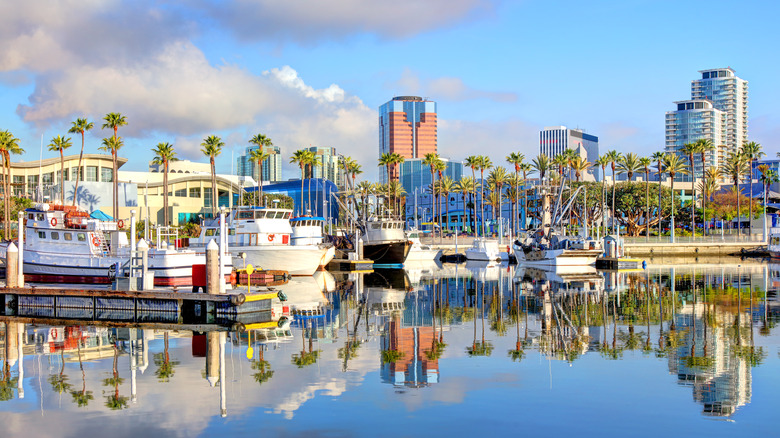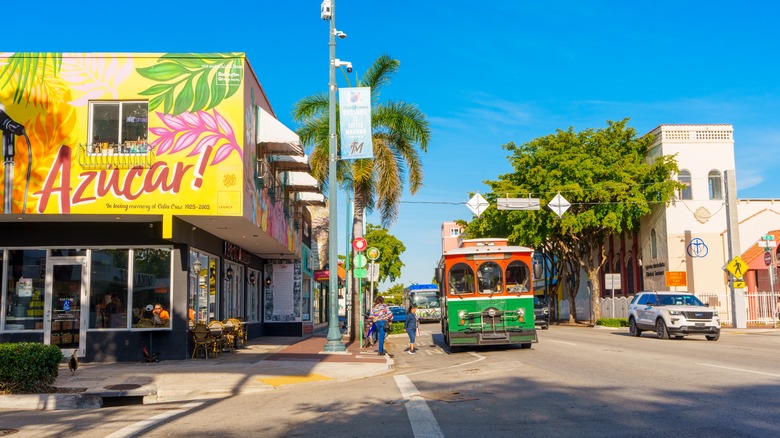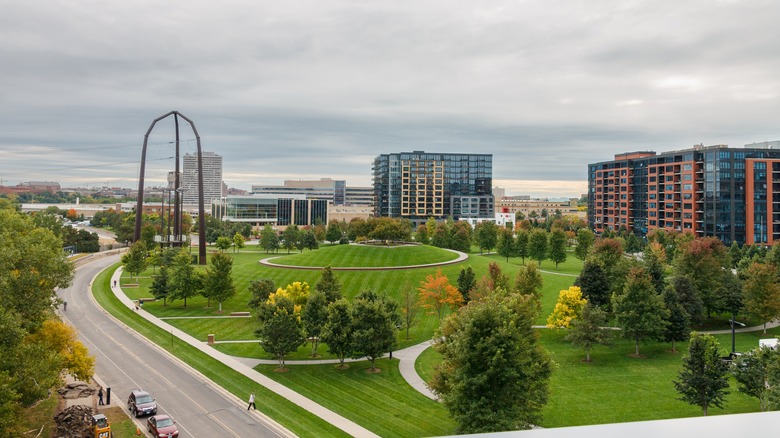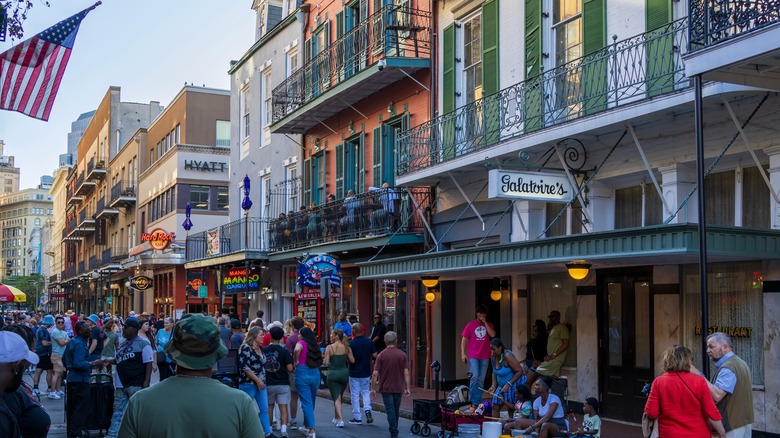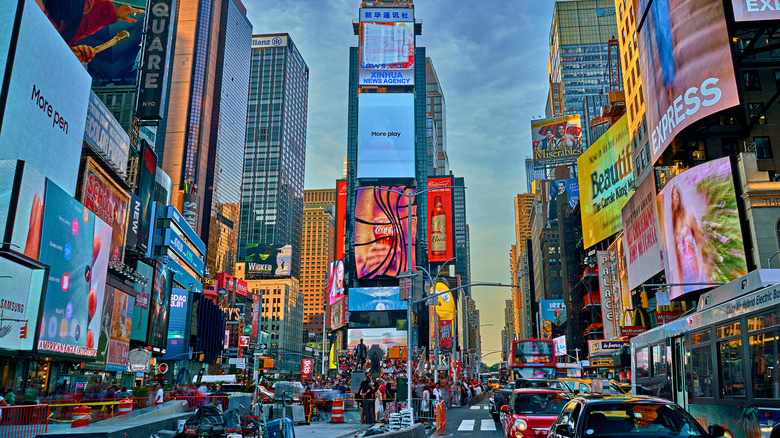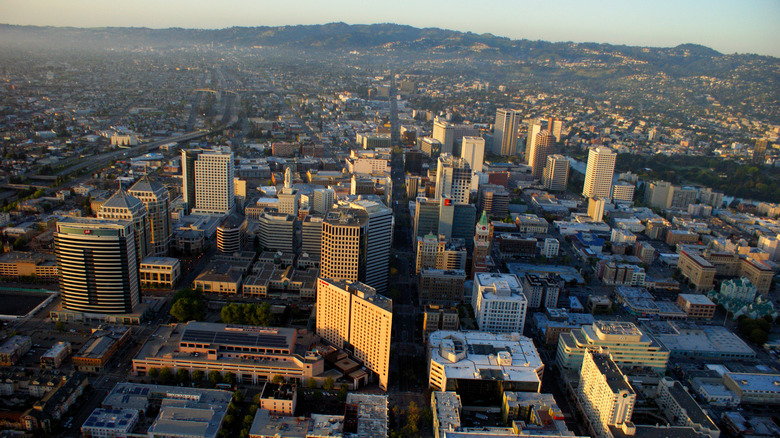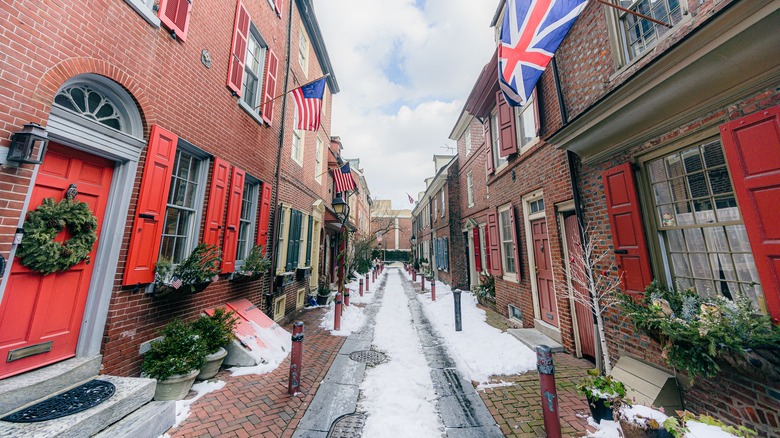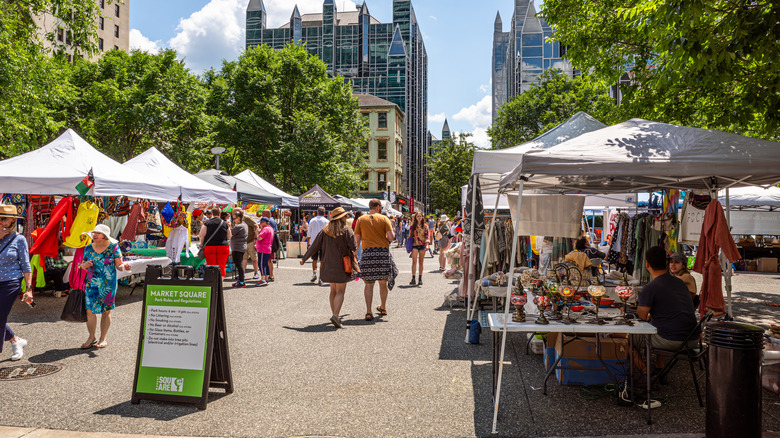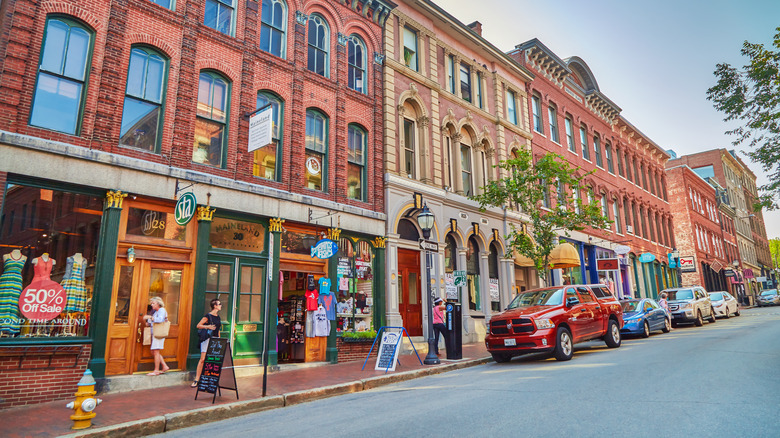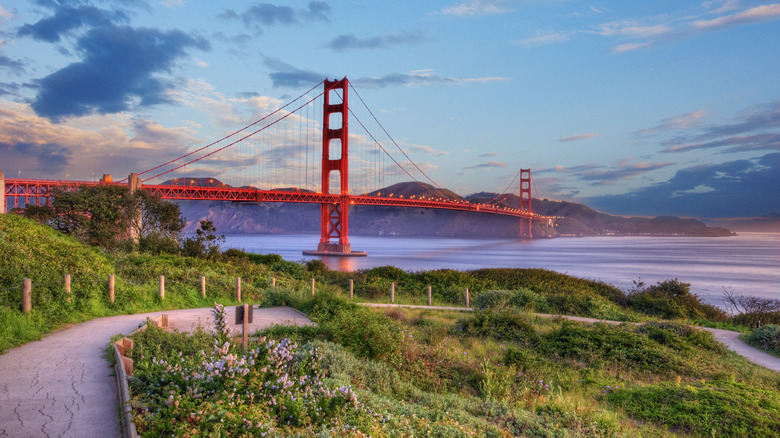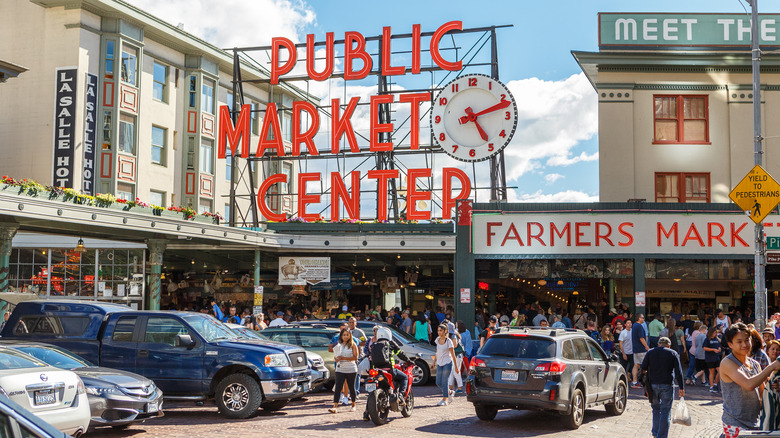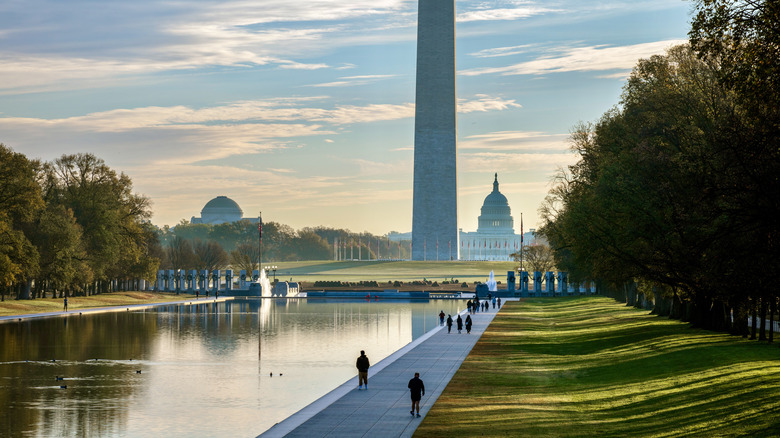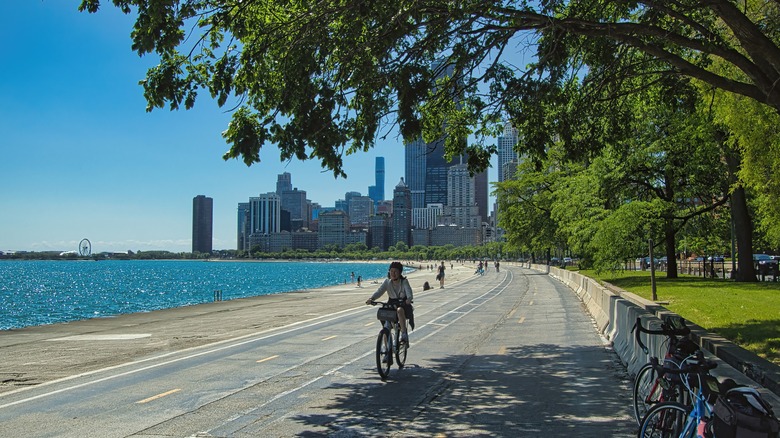America's Most Walkable Cities, According To Travelers
Seeing a city from a car, or an open-top bus, is convenient, and can be a quick way to get the lay of the land. But to really understand it, nothing beats walking around it. If you want to get under the skin of a city, to feel its fabric, padding around on foot lets you appreciate the details, the minutiae of everyday life. Walking is also an incredibly democratic method of travel. While not everyone has a car, or can even drive, walking is almost a universal option for travelers of all ages.
It's also very good for your health, reducing the risks of certain diseases. In the U.S., all cities have areas where walking is an efficient, and pleasant, way of getting around. But some cities really do stand out for the walkability. Using a combination of metrics, blogs, and forums, we've compiled a list of the most walkable cities in the country.
Boston
The largest city in Massachusetts, where nature lovers will thrive, Boston has a number of neighborhoods that are best explored on foot. The area of Beacon Hill is one of the most sought-after parts of the city, and sits close to the Massachusetts State House, one of the city's most iconic buildings. Beacon Hill itself is such a fine place to stroll because of its stock of attractive Federal and Greek Revival-style houses, and its place in the city's political history. Such is the appeal of this part of Boston to pedestrians that it is the site of organized walking tours.
Close to the center of the city, visitors will find North End, a residential neighborhood with a history that dates back more than 400 years. Today, travelers will continue to find narrow roads, small local businesses, part of the Freedom Trail, and part of the 43-mile Harborwalk there. Other areas of Boston good for exploring on foot are Harvard Square and Back Bay.
Chicago
Right in the heart of Illinois' economic powerhouse, travelers can plainly see how this city on the banks of the Chicago River rose from the ashes of a large fire that ravaged it in 1871. Some of the world's best architecture huddles around the river, including the Old Dearborn Bank, the NBC Tower, and the Carbide and Carbon Building. Best of all, they sit a short distance from the river and each other, making them easily discovered by tourists who choose to cover the city on foot.
These aren't the only great things to see along the Riverwalk. From the gleaming white, angular Tribune Tower and Wrigley Building to the scalloped cylinders that are Marina City, to gleaming glass skyscrapers, Chicago's river is the thread that connects the city's architectural gems. Beyond that, visitors can stroll for miles along Lake Michigan — the Lakefront Trail extends for 18 miles and is a paved pedestrian route that is free of car traffic. Near the lake, parks line the waterfront and offer green spaces that are ripe for exploration on foot. As one poster on Reddit noted, "The city is flat and very conducive to walking. It's hard to get lost, thanks to the grid system."
Jersey City
For many residents of New York City, Jersey City is like the Big Apple's less desirable step-child. It's physically separated from New York, located across the Hudson River, and isn't part of the city's subway system. Plus it's in New Jersey, an entirely different state. But none of these jibes, or gentle ribbing, really hold much weight when you realize that Jersey City is better connected to parts of Manhattan than most of Brooklyn or Queens. And from the waterfront of Jersey City, the views of the Big Apple's skyline are out of this world.
Jersey City gets a Walk Score rating of 87 (per Walk Score), meaning the set-up for pedestrians is outstanding. Looking at the Downtown area, the heart of Jersey City, that Walk Score rating rises to 99. The city is mostly flat, and there are plenty of restaurants and stores a short walk from many homes. Paved promenades along the waterfront also make leisure walks extremely pleasurable, and streets are often populated by trees, further adding to the ambulatory allure.
Long Beach
Long Beach has carved out a name for itself as one of the busiest ports in the United States. And yet this waterfront city is a great destination for wandering around on foot, with a number of distinct neighborhoods luring visitors and locals alike. The East Village is perhaps the most arts-driven part of the city. In it, travelers will find an assemblage of galleries, boutiques, cafes, and restaurants, and many of them are set within buildings that are imbued with a deep history.
This is also a part of the city that's a popular set location for Hollywood productions — "La La Land" is among the movies that have been filmed in the East Village. The neighborhoods of Belmont Shore and Naples might be the kind of idyllic, breezy scene that many tourists picture when imagining Long Beach. With a focal point of Second Street, a warren of restaurants, shops, and other entertainment, these areas present long beaches, boardwalks for taking in the sea breeze, and opulent homes close to the waterfront.
Miami
At this Floridian hotspot, one of America's best cities for nightlife, one good place to test out your sneakers is Little Havana, the traditional home of the city's Cuban population. The pulsing core of this neighborhood is Southwest Eighth Street, known locally as Calle Ocho. It retains a slightly exotic feel to it, from the restaurants selling classic Cuban fare, to the lively locals that congregate in the parks to play dominoes or shoot the breeze.
The districts of Edgewater and Wynwood sit by each other and are also fine spots for visitors looking to pound the pavement. The former has the crown jewel of Margaret Pace Park, a green space filled with palm trees and set right by the waterfront. The latter, Wynwood, is filled with places to eat, drink, and peruse art. There is more artistic wonder in Downtown Miami, with a selection of murals dotted around the center of the city, many along Flagler Street.
Minneapolis
A city on the banks of the Mississippi River, Minneapolis is blessed with parks along the riverfront. Gold Medal Park, for instance, is less than two decades old, and is more a place to reflect and unwind than to wander or explore. It's only 7.5 acres in size, with walking paths around it, and a raised section set among trees that comes with views of the river. East Rivers Flat Park, on the other side of the Mississippi, has grand green spaces, scores of cottonwood trees, and trails that shadow the broad river, great for a casual stroll.
The city has, in fact, engineered its planning in order to encourage walking. More than 90% of city streets have sidewalks on both sides, making Minneapolis a place where getting around is built into the urban fabric, and pretty intuitive. In Downtown West, in the heart of the city, you'll find many of the city's skyscrapers, and the Target Center stadium. Shoppers will delight in the area's Nicollet Mall, a mile-long pedestrian shopping area that has plenty of stores and restaurants to visit. Downtown is also where to find the Minneapolis Skyway System. This web of covered pedestrian bridges that span 80 blocks of downtown ensure that people can get round the core of the city on foot, whatever the weather.
New Orleans
Is there a more walkable part of the country than this city's French Quarter, home to a special gallery and a historic house serving famous food? This storied slice of the Big Easy gets an impressive Walk Score of 97. And the city, overall, was ranked the most walkable city in the United States by the British insurance company. In addition to the French Quarter, the Central Business District gets plaudit for its pedestrian-friendly attributes. These duo of city neighborhoods, located close to each other, allow visitors to see a number of iconic city sites within a short circumference. Drop by Café du Monde for the iconic coffee and beignets while in the French Quarter, stroll the renowned Bourbon Street, or marvel at the fine landscaping and the statue of Andrew Jackson at Jackson Square.
The French Quarter also features its own section of Riverwalk, hugging the shores of the Mississippi River for more than one mile a short distance away from Jackson Square. In the CBD, walkers will encounter chic restaurants and bakeries, hotels at every turn, and beautifully renovated theaters like the Orpheum and Saenger. Best of all, these two neighborhoods have in excess of 500 restaurants between them, so you'll never lack for places to grab a bite within a quick walk.
New York
If one phrase on the silver screen can effortlessly sum up the way New Yorkers view pedestrians as having greater rights than cars, it would be from the 1969 film "Midnight Cowboy." In it, Ratso Rizzo (played by Dustin Hoffman) slaps the hood of a taxi as he crosses the road and bellows, "I'm walkin' here." Study any movie that is set in New York, a city with some of the best budget-friendly outdoor activities, and you'll notice people always walking around on the streets, whether in a residential neighborhood in Brooklyn or Queens, or the skyscraper canyons of Manhattan. The truth is that in this city of more than eight million people, the car is definitely not king, and getting around on foot is often the quickest way to get from place to place.
In a 2014 study on the walkability of the city by the New York City Department of Health and Mental Hygiene, large sections of Manhattan (where many tourists visit), are shaded as highly walkable. There are so many places to explore on foot, that the list is endless. People cross the Brooklyn Bridge on foot every day for Insta-worthy shots of Downtown Manhattan. The High Line is an elevated park built on former freight train tracks, while the revered Central Park has trails that criss-cross the iconic green space. Parts of Times Square are entirely car free, a remarkable testimony to the power of the pedestrian in the Big Apple.
Oakland
Downtown Oakland has a Walk Score of 100 which shows that this is a fine spot for pedestrians. But it's not the only part of the city suitable for a stroller. For travelers who spend time going for a leisurely wander around the Uptown district, the pay-off is some striking Art Deco architecture. Among the stand-outs is the Floral Depot building, a corner structure with deep cobalt-colored facade tiles that alternate with some in silver terra cotta.
When the light catches the Fox Theater at a certain time of day, this Art Deco gem, with its cool neon sign climbing up the side of the building, almost glows like the sun. Over on Lake Merritt, birds are the main permanent residents. People can visit the wildlife refuge also thanks to a pedestrian walkway around its edge. And for walkers who want to fold a little adventure into their exploration, the Oakland Hills have trails through the wilds and offer distant views of San Francisco's skyscrapers.
Philadelphia
Self-guided walking tours of the Old City are just one of the joys here. As its name suggests, the Old City is the part of Philly that is most steeped in history, and it's where some of the country's earliest beginnings were first formed, way before cars were invented. A grid of narrow streets to the east of the city center, the Old City is where travelers will locate Independence Hall — where the U.S. Constitution was formulated.
The Liberty Bell is close by, and Graff House, also in the Old City, is where Thomas Jefferson put together the Declaration of Independence. There is much more to see in the Old City, from the place where Benjamin Franklin was buried, to Elfreth's Alley, the country's oldest residential block. All of this is easy to get to on foot, as are many other parts of the city. A poster on Reddit concurs. "After spending a good chunk of time in NYC, Philly is definitely more walkable overall ... The narrow streets keep traffic speeds low and makes walking feel safer."
Pittsburgh
Look at the statistics for Downtown Pittsburgh, and the numbers make for some mouthwatering reading. There are more than 250 restaurants and 60 outdoor cafes. Shops selling everything from clothing to accessories number almost 200, while leisure seekers can retire to about 50 acres of parklands — Market Square among them. There are even sections of riverfront along the Allegheny River where walkers can stroll.
Point State Park is a must-see part of the city. Located where three rivers meet, it has remnants of old forts within its borders, and the city's oldest building in its Fort Pitt Blockhouse. The city views are spectacular from this waterfront park. Tourists looking to burn some calories on a walk can hit one of the city's many trails. The Eliza Furnace Trail and Southside Riverfront Trail, for instance, both supply paved pathways for bikers and walkers, and often cross bridges that come with fabulous city vistas.
Portland
So forward-thinking was Portland, that it published its first pedestrian plan in 1998. The most recent iteration of that framework was a status report covering the years 2019-2022, and it shows the city's unerring desire to place pedestrians front and center in its scheme for holistic urban planning. Upgrades to sidewalks and crosswalks are included, as are areas where improvements still need to be made. The bottom line is that Portland is a fine place for a pedestrian. Downtown, Pioneer Courthouse Square is the heart of the city, lined with shops and restaurants, museums, and performance spaces.
Downtown also skirts the Willamette River, and visitors will find pathways running alongside the water. A former industrial zone resuscitated to become a hotspot of restaurants, independent stores, and galleries, the Pearl District is easy to walk around, and in doing so, travelers will also find public artworks and lively markets. For some pretty residential displays, wander around Nob Hill and you'll come across ornate Victorian homes set on calming tree-lined roads. In the Alberta Arts District, the main drag Alberta Street is set up for pedestrians, and features studios, performance venues, and local galleries.
San Francisco
This hilly city by the bay constantly focuses on pedestrian safety when fine-tuning urban planning improvements. Among the goals of the local authorities is to "increase the number of walking trips" among residents. Areas that have high incidences of accidents with pedestrians are targeted and measures such as making curbs and crosswalks more visible are undertaken. These targeted methods of making the city more walker-friendly seem to work, as San Francisco is Walk Score's most walkable city in the U.S. —it gets an overall score of 89. Given this accolade, the city has a broad choice of places that are great for a sidewalk shuffle.
One of the most famous Chinatowns in the country is jammed with narrow alleys, statues, shops, and places of worship. For some colorful street art, travelers can amble along the streets of the Mission district where vibrant murals grace the walls. In the Presidio, the city has a fantastic urban park, one with beaches, green spaces, and some of the best views of the Golden Gate Bridge around.
Seattle
The beauty of Downtown Seattle is its ability to squeeze a lot into a small area. This isn't a large, sprawling area that's dominated by broad, snaking roads, but a compact realm, extremely walkable, and packed with facilities, including more than 800 restaurants. Other numbers help to tell the story of why the center of Seattle is such a good destination for pedestrians. Downtown is only eight blocks in width, so nothing within it is far from anything else.
Of the city's 17,000 hotel rooms, nearly half are clustered in or around Downtown. The Pike Place Market, one of the city's prime sites, is in Downtown. The market is one part of the city not to miss, and it's definitely best experienced on foot. It first debuted in 1907, and today extends across nine acres of space in the heart of Seattle. In addition to farmers hawking their goods at the market, visitors will find stores and restaurants, artisans, and even buskers.
Washington, D.C.
Look at a map of D.C., and you can't help but notice a broad slash of green running through a section of it. That is the National Mall, a giant park that's easily walkable. Largely free of traffic, not only is this a vital green space that defines the city, but it also acts as a conduit, a thoroughfare that binds the many museums all around its edges. Along the north, tourists will encounter the Smithsonian National Museum of Natural History, the National Gallery of Art, and the National Museum of African American History and Culture.
Along the south, sit the National Museum of the American Indian, and the Smithsonian National Air and Space Museum. At opposite ends of the mall, a brisk walk from each other, face off the United States Capitol, and the Washington Monument, with the Lincoln Memorial beyond. So much to see, and best of all, you can visit them all on foot.
Methodology
To put together this list of the most walkable cities in the U.S., we started by looking at blogs like USA Today and Landing. We then used statistics from Walk Score, a metric that assesses the walkability of a location, and Smart Growth America. This way we could ensure that the choices were empirically sound.
